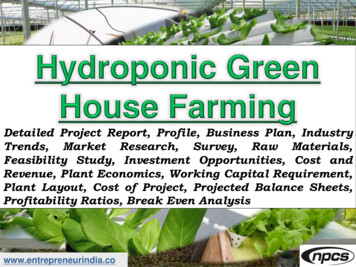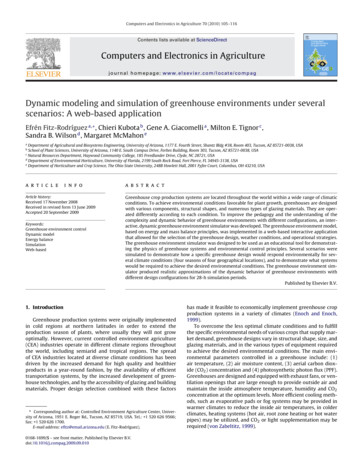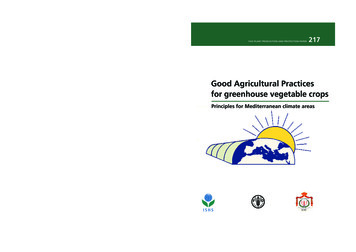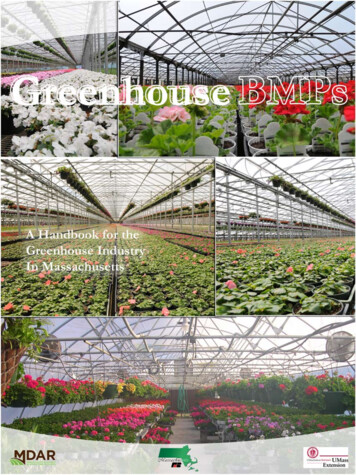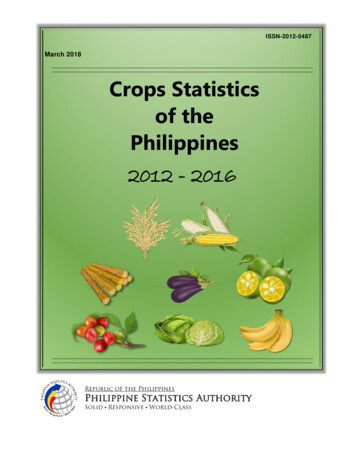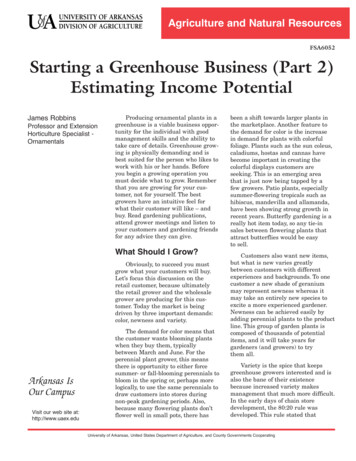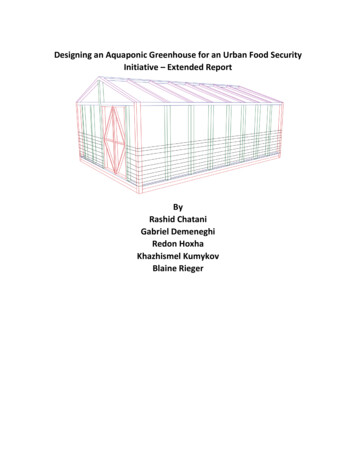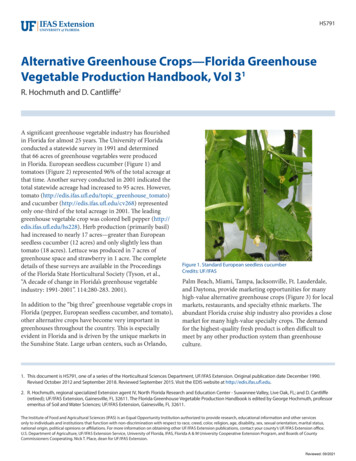
Transcription
HS791Alternative Greenhouse Crops—Florida GreenhouseVegetable Production Handbook, Vol 31R. Hochmuth and D. Cantliffe2A significant greenhouse vegetable industry has flourishedin Florida for almost 25 years. The University of Floridaconducted a statewide survey in 1991 and determinedthat 66 acres of greenhouse vegetables were producedin Florida. European seedless cucumber (Figure 1) andtomatoes (Figure 2) represented 96% of the total acreage atthat time. Another survey conducted in 2001 indicated thetotal statewide acreage had increased to 95 acres. However,tomato (http://edis.ifas.ufl.edu/topic greenhouse tomato)and cucumber (http://edis.ifas.ufl.edu/cv268) representedonly one-third of the total acreage in 2001. The leadinggreenhouse vegetable crop was colored bell pepper (http://edis.ifas.ufl.edu/hs228). Herb production (primarily basil)had increased to nearly 17 acres—greater than Europeanseedless cucumber (12 acres) and only slightly less thantomato (18 acres). Lettuce was produced in 7 acres ofgreenhouse space and strawberry in 1 acre. The completedetails of these surveys are available in the Proceedingsof the Florida State Horticultural Society (Tyson, et al.,“A decade of change in Florida’s greenhouse vegetableindustry: 1991-2001”. 114:280-283. 2001).In addition to the “big three” greenhouse vegetable crops inFlorida (pepper, European seedless cucumber, and tomato),other alternative crops have become very important ingreenhouses throughout the country. This is especiallyevident in Florida and is driven by the unique markets inthe Sunshine State. Large urban centers, such as Orlando,Figure 1. Standard European seedless cucumberCredits: UF/IFASPalm Beach, Miami, Tampa, Jacksonville, Ft. Lauderdale,and Daytona, provide marketing opportunities for manyhigh-value alternative greenhouse crops (Figure 3) for localmarkets, restaurants, and specialty ethnic markets. Theabundant Florida cruise ship industry also provides a closemarket for many high-value specialty crops. The demandfor the highest-quality fresh product is often difficult tomeet by any other production system than greenhouseculture.1. This document is HS791, one of a series of the Horticultural Sciences Department, UF/IFAS Extension. Original publication date December 1990.Revised October 2012 and September 2018. Reviewed September 2015. Visit the EDIS website at http://edis.ifas.ufl.edu.2. R. Hochmuth, regional specialized Extension agent IV, North Florida Research and Education Center - Suwannee Valley, Live Oak, FL; and D. Cantliffe(retired); UF/IFAS Extension, Gainesville, FL 32611. The Florida Greenhouse Vegetable Production Handbook is edited by George Hochmuth, professoremeritus of Soil and Water Sciences; UF/IFAS Extension, Gainesville, FL 32611.The Institute of Food and Agricultural Sciences (IFAS) is an Equal Opportunity Institution authorized to provide research, educational information and other servicesonly to individuals and institutions that function with non-discrimination with respect to race, creed, color, religion, age, disability, sex, sexual orientation, marital status,national origin, political opinions or affiliations. For more information on obtaining other UF/IFAS Extension publications, contact your county’s UF/IFAS Extension office.U.S. Department of Agriculture, UF/IFAS Extension Service, University of Florida, IFAS, Florida A & M University Cooperative Extension Program, and Boards of CountyCommissioners Cooperating. Nick T. Place, dean for UF/IFAS Extension.Reviewed: 09/2021
The discussion will, however, include nontraditional typesof the “big three.”Mini CucumberMini cucumber, also known as Beit Alpha or Persian type(Figure 4), is smaller than the standard European seedlesscucumber and has become a popular new crop (http://edis.ifas.ufl.edu/cv277). The Beit Alpha cucumber is relativelynew to the United States and is the main cucumber typegrown in Israel and Spain and exported to Europe. There isalso extensive production in Mexico and Canada. The BeitAlpha cucumber originated in Israel but is now being soldthroughout the world.Figure 2. Florida greenhouse tomatoesCredits: UF/IFASBeit Alpha cucumbers are gynoecious (all female), parthenocarpic (develop fruit without pollination) hybrids, andthey have a gene for flower clustering, which means manyfruit set at each internode (Figure 5). The fruit is seedlessand has a thin skin like the traditional longer Europeancultivars. It does not require plastic shrink wrapping toprevent dehydration after harvest. Many consider theflavor as tops among all fresh cucumber types. Fruit areharvested at a very immature stage for highest quality. Thisis a major advantage in the cost of postharvest handlingand marketing. Fruit production is prolific for Beit Alphacultivars; many of the small fruits are set on each nodeand on the laterals. Yields can be compact (10 harvests orless) or continuous (more than 30 harvests), depending onthe season. Beit Alpha cultivars grow well under extremeFigure 3. Diversity of alternative greenhouse vegetable cropsCredits: UF/IFASMuch of the recent expansion of the greenhouse hydroponic industry in Florida is a result of small farmersseeking to enter the marketplace with locally grown freshproduce. In many cases, these growers are part-timefarmers and see this strategy as an affordable way to get intofarming on small tracts of land. The marketing strategy forlocal sales generally means a small grower needs to producea variety of crops, rather than one or two for a largerwholesale market. Direct sales to consumers are generallyhigher when the grower has a mix of crops to sell at themarket. Several crops other than the “big three” are beingsuccessfully grown and marketed now, and the Universityof Florida is continuously evaluating others.In 2012, it was estimated that 500 acres or more of all ediblecrops were being grown in some type of protected culturein Florida. This publication discusses some of the alternative or specialty crops being grown and marketed, otherthan traditional greenhouse tomato, cucumber, and pepper.Figure 4. Standard European seedless cucumber (left) and smaller BeitAlpha cucumber (right)Credits: UF/IFASAlternative Greenhouse Crops—Florida Greenhouse Vegetable Production Handbook, Vol 32
Lettuces and Other Leafy GreenVegetablesThe traditional greenhouse lettuce crop in Florida andelsewhere is a bibb-heading type normally grown innutrient film technique (NFT) channels (Figure 6) or in afloating system (Figure 7). The product is usually sold as a“living plant” with the roots still attached and packaged ina bag or special plastic clam shell. Lettuce is also producedfor baby greens and salad types. Lettuce is a fast-growingcrop, typically taking 30–35 days from seeding to harvest.Growing lettuce in the warm season in Florida makes thedisorder known as leaf tip burn more difficult to manage.Environmental controls for temperature, light, cultivarselection, and good calcium nutrition are all critical toproperly managing leaf tip burn.Figure 5. Several Beit Alpha cucumbers set at each internodeCredits: UF/IFASenvironmental conditions, especially under the hightemperatures (90 F–95 F) common much of the year inFlorida greenhouses. These cucumbers are sensitive to lowtemperatures, especially in the seedling stage. They can beproduced on a year-round basis, provided temperaturesinside the greenhouse are not permitted to drop below 35 F.Figure 6. Lettuce grown in a nutrient film technique systemCredits: UF/IFASThe University of Florida has conducted several productionand postharvest trials in Gainesville, Citra, and Live Oak.Several cultivars have produced very high marketableyields, equivalent to and occasionally higher than standardEuropean cucumber types. Most Beit Alpha types producefruits 5–8 inches in length. The specific fruit size is important in certain ethnic markets. Management of powderymildew was a primary production challenge in the past.Most early released cultivars were very susceptible to thedisease; however, newer releases have excellent tolerance.Several cultivars have been evaluated at the SuwanneeValley Agricultural Extension Center near Live Oak, andhorticultural sciences faculty members in Gainesvillehave evaluated a dozen others. Cultivars such as ‘Manar’and ‘Jawell’ have consistently performed well. For currentcultivar recommendations, contact your county Extensionagent or greenhouse vegetable seed dealer.Figure 7. Floating stystem for lettuce and other vegetable cropsCredits: UF/IFASAlternative Greenhouse Crops—Florida Greenhouse Vegetable Production Handbook, Vol 33
Even though demand for bibb lettuce is still very high,there are new opportunities for greenhouse and outdoorhydroponic growers to see other specialty leafy greenvegetable crops, especially at local upscale markets. Recenteducational programs in Florida have connected growerswith restaurant chefs. These programs revealed greatinterest among chefs to purchase specialty salad greens andfresh herbs. Developing production systems and timingproduction schedules for these markets can be very challenging. Many small hydroponic growers whose crops growinside greenhouses, high tunnels, under shaded structures,and even outdoors in Florida are producing severalspecialty lettuces and other leafy greens to be sold directlyto consumers on the farm and at local farmers markets. Inthese cases, a wide variety of colors and lettuce types havebecome popular, including loose leaf, romaine, and summertypes. In addition to lettuce, many growers report greatdemand locally for other leafy greens, such as Swiss chard,spinach, kale, and mustard (Figure 8).Culinary HerbsIn the last two decades, there has been a dramatic increasein greenhouse herb production in Florida, from virtuallynone in 1991 to nearly 17 acres in 2001. The most popularherb now grown in Florida greenhouses is basil; however,dozens of other herbs are also being grown, includingchives. Herbs have a long history of human use. In ancienttimes, as well as today, herbs were used for medicinal,cosmetic, and culinary purposes. The demand for fresh-cutherbs is expected to continue to increase, in part because ofhealth-conscious consumers and increasing consumptionof ethnic cuisine. Greenhouse production of herbs offersseveral production and market advantages, including morerapid plant growth, the ability to provide specific culturalFigure 8. Swiss chard and kale ready for marketCredits: Kevin Osburnand nutritional requirements, wintertime productionwhen market prices are highest, and a clean product. Theclean hydroponic product may not require washing priorto shipment, which contributes to a longer shelf-life anda high-quality appearance. Seventy-eight percent of herbbuyers responding to a national survey rated quality as themost important factor in selecting herb suppliers.The University of Florida conducted studies at Live Oakto document the marketable yield of selected fresh-cutherbs (Figure 9) from fall through spring in a verticalhydroponic greenhouse production system (Verti-Gro ).Herbs included in the trial were arugula (Eruca vesicaria),basil (Ocimum basilicum), purple basil (Ocimum basilicum),chervil (Anthriscus cerefolium), dill (Anethum graveolens),lemon balm (Melissa officinalis), sweet marjoram (Origanum majorana), oregano (Origanum vulgare), parsley(Petroselinum crispum), Italian (flat leaf) parsley (Petroselinum crispum), sage (Salvia officinalis), and thyme (Thymusvulgaris). The best overall performers in the vertical systemswere basil, oregano, parsley, sweet marjoram, and thyme.Basil, the most popular herb among local consumers inFlorida, is commonly grown for fresh-cut harvest in a widevariety of containers filled with soilless media and alsogrown for whole-plant sales in NFT systems (Figure 10).Other successful trials for herb production have includedmints and chives in lay-flat bags filled with perlite. As withmost greenhouse specialty crops, growers must becomeespecially knowledgeable about the differences in herbpricing, packaging, postharvest handling, and marketingfor success and profit. ‘Galia’ Muskmelon‘Galia’ muskmelon (Cucumis melo Reticulatus group L.)could become another hydroponic crop favorite (http://edis.ifas.ufl.edu/hs147). The ‘Galia’ melon is a green-fleshedFigure 9. Vertical culture of herbs and other specialty cropsCredits: UF/IFASAlternative Greenhouse Crops—Florida Greenhouse Vegetable Production Handbook, Vol 34
Figure 10. Basil production in nutrient film techniqueCredits: UF/IFASmuskmelon with a golden to yellow netted rind at maturity(Figure 11). ‘Galia’ fruits have a unique aroma and sweetflavor, and they show promise as a greenhouse specialtymelon (Figure 12). The quality of ‘Galia’ fruit grownhydroponically in a protected structure can surpass thequality of field-grown orange muskmelons because of theirbold aroma and high sugar content, which leads to highermarket value. The secret to successful multiple fruit production is pruning, which is labor intensive (Figure 13). Newer‘Galia’ cultivars ship well and are more disease resistant.The Florida field vegetable industry is facing manychallenges, including the loss of the soil fumigant methylFigure 12. Greenhouse culture of specialty melonsCredits: UF/IFASbromide; increased regulations on food safety, water,fertilizer, and pesticide use; increased urbanization and lossof production land in southern Florida; challenges fromweather, including freezes, wind, and rain; and increasedregional and global market competition. Alternativegrowing methods, such as protected agriculture in nontraditional growing regions of Florida, are necessary to staycompetitive, as are new specialty commodities like ‘Galia’melon.In Europe, ‘Galia’ melons are in high demand and wellknown for their superior quality and high soluble solids;furthermore, ‘Galia’ has become an identifiable trade name.Figure 11. ‘Galia’ green-fleshed muskmelonCredits: UF/IFASUniversity of Florida researchers have evaluated severalaspects of ‘Galia’ muskmelon production, including cultivarselection, nutrient management, soilless media, diseaseand insect management, pruning methods, and pollination. Disease and insect management can be especiallychallenging in greenhouse muskmelons grown in Florida.Currently, this is a very specialized niche market in Florida;however, as production challenges are solved and consumeracceptance increases, ‘Galia’ muskmelon may become aviable alternative greenhouse crop in the future. They mustbe harvested at half or full slip (tearing at the peduncle end)to achieve maximum flavor and sweetness. Presently, somefield-grown ‘Galia’ melons are harvested very immature andthus never achieve any flavor, sweetness, or aroma.Alternative Greenhouse Crops—Florida Greenhouse Vegetable Production Handbook, Vol 35
and market this delicate, immature fruit. Squash cultivars,including zucchini, yellow summer, patty pan/scallop,and cousa, can be grown hydroponically in a greenhouse(Figure 15).Figure 13. Pruning technique for Galia melonsCredits: UF/IFASSquash are graded as “baby” when they are less than 4inches in length for zucchini, yellow summer, and cousaand less than 1.5 inches in diameter for round and pattypan/scallop. The use of commercially available bumble beesis important for good pollination and uniform shape. Zucchini produce between 16 and 25 baby-sized fruit per plant.Yellow summer squash have produced more than 45 babyfruit per plant in University of Florida trials. Patty pan/scallop squash production ranged from 50 to 67 baby-sizedfruit, and cousa produced approximately 30 baby-sizedfruit per plant. Squash plants can produce numerous‘Charentais’ CantaloupePopular in France, ‘Charentais’ cantaloupes boast anextremely fragrant and sweet, orange flesh (Figure 14).In the United States, ‘Charentais’ melons were not widelygrown because of their short shelf-life and susceptibilityto powdery mildew. Recently, however, new cultivars havebeen released with longer shelf-life and better powderymildew resistance. ‘Charentais’ cantaloupes are producedin a similar fashion to ‘Galia’ melons. Average fruit numbercan be greater than four per plant. Soluble solids content(sugars) can be greater than 16 Brix, which is excellent inmelons.Baby Squash and Squash FlowersMini or “baby” vegetables have become increasinglypopular items for restaurant chefs and retail sales. Squash(Cucurbita pepo) are generally cultivated in open fieldswhere climate, insect, and disease pressures create challenging conditions for growers and shippers who produceFigure 14. Charentais fruit grown in a greenhouseCredits: UF/IFASFigure 15. Several cultivars grown and sold as baby squashCredits: UF/IFASFigure 16. Dr. Dan Cantliffe with male squash flower (left) and femaleflower (right)Credits: UF/IFASAlternative Greenhouse Crops—Florida Greenhouse Vegetable Production Handbook, Vol 36
high-quality baby-sized fruit when grown hydroponicallyin a reduced pesticide greenhouse environment where theycan be harvested, packaged, and distributed to buyers daily.Field cultivars ‘Hurricane’, ‘Raven’, ‘Gold Rush’, ‘Goldy’, ‘Sunray’, ‘Seneca Supreme’, ‘Supersett’, ‘Butter Scallop’, ‘Sunburst’,‘Patty Green Tint’, ‘Starship’, ‘Magda’, and ‘HA-187’ have allbeen successfully used for hydroponic baby squash production. While the female flower is harvested for baby fruit,the male flower is in high demand by top-end restaurants(Figure 16). The male flower should be harvested withcomplete stamens, either on the day before or the morningof opening, then bagged and cold stored before rapiddelivery to the intended buyer. Because of high demand andlack of supply, prices are exceptionally high for quality malesquash flowers, up to 1 per flower.StrawberryFigure 17. Greenhouse strawberry production in raised media-filledtroughsCredits: UF/IFASStrawberry production in a greenhouse (Figure 17), hightunnel (Figure 18), or in an outdoor hydroponic systemhas captured the imagination of many over the past severalyears. This crops many attributes make the greenhouseconcept appealing, including high fruit values, protectionfrom freezing temperatures, high value in the off season,difficulty with labor harvesting (low crop culture), and thechallenge of finding suitable alternatives to soil fumigation.The greatest adoption of nontraditional strawberry production methods in Florida has been with outdoor verticalhydroponic systems and production in simple high tunnels.Strawberries are produced inside high tunnels with bothin-ground and soilless culture (http://edis.ifas.ufl.edu/hs407).Recent University of Florida research has focused oncultivar selection as well as new production and pestmanagement systems for greenhouse and high-tunnelstrawberry. In particular, greenhouse strawberries are moresusceptible to pests, such as spider mites and powderymildew. Insects and mites can be managed using biologicalcontrol measures, and powdery mildew can be controlledwith sulfur applications.Specialty Cut and Edible FlowersAs consumers demand highly specialized crops, greenhouseproducers should consider meeting these needs. Often thelocal market demands crops in a condition or at a time thatcan only be met by using the protection of a greenhouse.Among these specialty crops being grown on small commercial acreage in Florida, primarily for local sales, arefresh-cut flowers and edible flowers.Figure 18. Vertical culture of strawberries in a high tunnelCredits: UF/IFASUniversity of Florida efforts near Live Oak have beensuccessful in refining a production system for cut flowerssimilar to that used for vegetables. This project evolved outof greenhouse vegetable growers wanting to produce otherprofitable greenhouse crops and diversify their offerings atlocal markets. The crops that have the most potential arethose specialty cut flowers that are difficult to ship fromother larger, distant production areas (Figure 19). Theseinclude flowers such as zinnia (Figure 20), snapdragon,sunflower, delphinium, stock, dianthus, and lisianthus.Small growers in Florida have been successful in producingtop-quality flowers, targeting local sales at both farmersmarkets and florists. Expansion of these local marketingefforts depends upon growers being able to grow severalAlternative Greenhouse Crops—Florida Greenhouse Vegetable Production Handbook, Vol 37
Figure 19. Specialty cut flowers as an alternative crop for local marketsCredits: UF/IFASFigure 21. Nasturtium grown as an edible flower in a vertical systemCredits: UF/IFASFigure 20. Zinnia grown as a greenhouse cut flowerCredits: UF/IFASdifferent species to maximize the number of specialty cutssold on a weekly basis. Flowers that continue to branch andproduce more cuts on the same plant over a long period oftime have shown to be the most profitable candidates. Zinnia and snapdragon, for instance, have this type of growthhabit. In some cases, growers need to be sure to providespecial lighting requirements during certain times of year.Edible flowers can be good companion crops for localgreenhouse growers, especially herb producers. Althoughthe demand is small, the value is high and the opportunityto provide high-quality edible flowers to chefs in urbanFlorida restaurants is great. Postharvest handling andpackaging are very important in successfully adding edibleflowers to a grower’s list of specialty crops. Vertical production (Verti-Gro ) of these has been highly successful in Figure 22. Viola edible flowersCredits: UF/IFAStrials at the Suwannee Valley Agricultural Extension Centernear Live Oak. Edible varieties of nasturtium (Figure 21),viola (Figure 22), stock, and marigold have all been successfully produced in trials at Live Oak.Microgreens and Baby GreensFrequently called “vegetable confetti,” microgreens (http://edis.ifas.ufl.edu/hs1164) are young, tender greens thatare used to enhance the color, texture, or flavor of salads,or to garnish a wide variety of main dishes (Figure 23).Harvested at the first true leaf stage and sold with the stem,Alternative Greenhouse Crops—Florida Greenhouse Vegetable Production Handbook, Vol 38
cotyledons (seed leaves), and first true leaves attached, theyare among a variety of novel salad greens available on themarket that are typically distinguished categorically by theirsize and age (Figure 24). Sprouts, microgreens, and babygreens are simply those greens harvested and consumed inan immature state. Based on size or age of salad crop categories, sprouts are the youngest and smallest, microgreensare slightly larger and older (usually 2 inches tall), and babygreens are the oldest and largest (usually 3–4 inches tall).Both baby greens and microgreens lack any legal definition.The terms “baby greens” and “microgreens” are marketingterms used to describe their respective categories. Sproutsare germinated seeds and are typically consumed as anentire plant (root, seed, and shoot), depending on thespecies. For example, sprouts from almond, pumpkin,and peanut reportedly have a preferred flavor whenharvested prior to root development. Sprouts are legallydefined and have additional regulations concerning theirproduction and marketing because of the relatively highrisk of microbial contamination compared to other greens.Growers interested in producing sprouts for sale need to beaware of the risks and precautions summarized in the FDApublication Guidance for Industry: Reducing Microbial FoodSafety Hazards for Sprouted Seeds cts/ucm120244.htm).The crops used for microgreens usually do not includelettuces because they are too delicate and wilt easily. Thekinds of crops that are selected for production and saleas microgreens have value in terms of color (like redor purple), unique textures, or distinct flavors. In fact,microgreens are often marketed as specialty mixes, such as“sweet,” “mild,” “colorful,” or “spicy.” Certain microgreencrops germinate easily and grow quickly. These includecabbage, beet, kale, kohlrabi, mizuna, mustard, radish,Swiss chard, and amaranth. As many as 80–100 crops andcrop varieties have reportedly been used as microgreens.Others that have been used include carrot, cress, arugula,basil, onion, chive, broccoli, fennel, lemongrass, popcorn,buckwheat, spinach, sweet pea, and celery. Growers shouldevaluate various crop varieties to determine their value asmicrogreens. Many seed companies are very knowledgeableabout the crops and varieties to grow, and a number ofthem offer organic seed.Microgreens can be grown in a standard, sterile, loose, soilless germinating media (Figure 25). Many mixes have beenused successfully with peat, vermiculite, perlite, coconutfiber, and others. Partially fill a tray with the media ofchoice to a depth of 1/2 inch to 1 or 2 inches, depending onirrigation programs. Overhead mist irrigation is generallyused in this media system. A commonly used commercialproduction system uses one of several materials as a mat orlining to be placed in the bottom of a tray or longer trough(Figure 26). These materials are generally fiber-like andprovide an excellent seeding bed.Figure 23. Microgreens grown in greenhousesCredits: UF/IFASThe commercial marketing of microgreens is mainlytargeted toward restaurant chefs or upscale grocery stores.Microgreens are ready for harvest when they reach the firsttrue leaf stage, usually at about 2 inches tall. Time fromFigure 24. Microgreens ready for harvestCredits: UF/IFASFigure 25. Microgreens grown in media-filled traysCredits: UF/IFASAlternative Greenhouse Crops—Florida Greenhouse Vegetable Production Handbook, Vol 39
Figure 27. Greenhouse-grown colored bell pepper (foreground)Credits: UF/IFASFigure 26. Microgreens grown in fiber mats in a recirculating troughsystemCredits: UF/IFASseeding to harvest can vary greatly by crop from 7 to 21days. Production in small trays will likely require harvesting with scissors, which is a very time-consuming part ofthe production cycle and is often mentioned by growersas a major drawback. The seeding mat type of productionsystem has gained popularity with many growers becauseit facilitates faster harvesting and in some cases can be solddirectly to chefs, allowing them to harvest as needed.Specialty Cultivars of SolonaceousCrops (Pepper, Tomato, andEggplant)Colored peppers (Figure 27) and beefsteak (Figure 28) orcluster tomatoes are considered traditional greenhousevegetable crops. These crops, along with their relative,eggplant, can also provide alternative crop opportunitiesfor small greenhouse growers if nontraditional cultivarsare used. Such examples being produced in Florida includeheirloom tomatoes (Figure 29), hot or other specialtypeppers, and unusual types of eggplants. In some cases,producing many specialized varieties of vegetable cropsat the same time in the field can be very difficult becauseof diseases, insects, or weather problems. The controlledgreenhouse environment may create opportunities toproduce specialty crops, like heirloom tomatoes, off-seasonspecialty pepper, or tender eggplant varieties. These aretypically opportunities for small and more specializedgreenhouse operations. Heirloom tomatoes are in veryhigh demand among upscale restaurants and local directto-consumer markets (Figure 30). These highly perishablefruit command high prices of 3– 6 per pound in certainmarkets. However, heirloom tomatoes are very challengingto grow because they have limited or no disease tolerance,are very susceptible to cracking, have relatively low yields,do not set fruit in very high temperatures, have highlyvariable fruit quality, and are difficult to prune and train toa production system. These production challenges create anadvantage to the excellent growers who can better managethese difficulties. Other specialty tomato types being growninclude grape (Figure 31), cocktail (Figure 32), cherry, andcultivars with varying colors of all types.Greenhouse peppers are generally sold as a large bellpepper, typically red, yellow, or orange in color (http://edis.ifas.ufl.edu/hs228). However, many other specialty peppers can easily be grown in protected culture (Figure 33).Recently, there has been an increase in pepper productionunder open-shade systems (http://edis.ifas.ufl.edu/hs368) toextend production well into the heat of Florida’s summers(Figure 34). This system has mainly been used to extendthe season for green bell peppers. Colored peppers seemto require more environmental controls as provided by theshelter of greenhouses or high tunnels.Figure 28. Traditional beefsteak tomato cluster a few days from harvestCredits: UF/IFASAlternative Greenhouse Crops—Florida Greenhouse Vegetable Production Handbook, Vol 310
Figure 29. Heirloom tomato cultivars provide diverse colors, shapesand sizes. Credits: UF/IFASFigure 32. Specialty small cocktail tomatoesCredits: UF/IFASFigure 30. Heirloom tomatoes grown hydroponically for local salesCredits: UF/IFASFigure 33. Wide variety of specialty peppers for direct marketingCredits: Kevin OsburnLocal demand for specialty peppers seems highly variablein the state, but examples of specialty peppers that aregaining popularity include poblano, jalapeno, cubanelle, hotDatil (Figure 35), unusual sweet types, and small coloredtypes.Figure 31. Grape tomatoes in hydroponic cultureCredits: UF/IFASEggplant is not normally considered a greenhouse crop.However, in diversified operations, eggplants have founda place among the offerings. The types being grown areslender, long, mild fruit types or ones with unusual colorsor color patterns (Figure 36). Eggplants have higherlight requirements for fruit set but can tolerate hightemperatures.Alternative Greenhouse Crops—Florida Greenhouse Vegetable Production Handbook, Vol 311
Figure 34. Green bell pepper grown under open-shade structureCredits: UF/IFASFigure 35. Greenhouse hot Datil peppe
Culinary Herbs In the last two decades, there has been a dramatic increase in greenhouse herb production in Florida, from virtually none in 1991 to nearly 17 acres in 2001. The most popular herb now grown in Florida greenhouses is basil; however, dozens of other herbs are also being grown, including chives. Herbs have a long history of human use.

